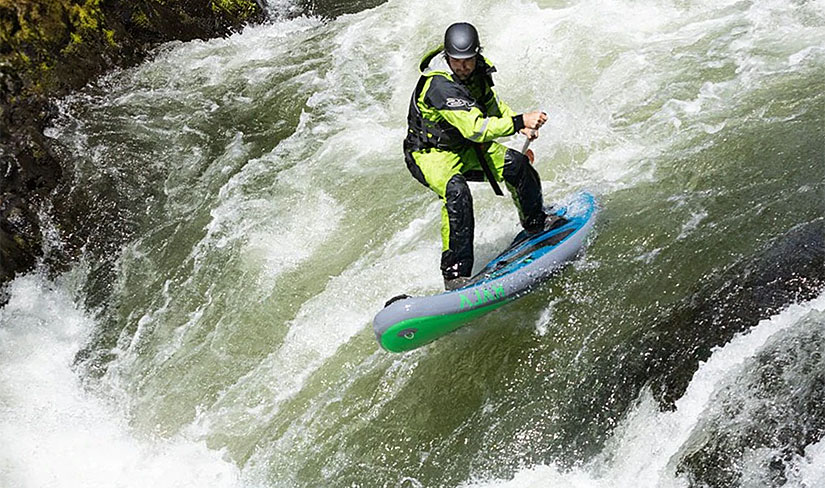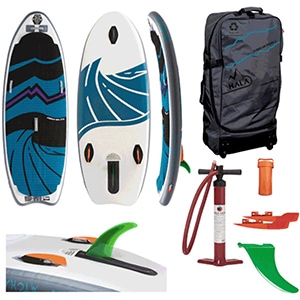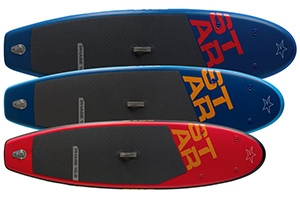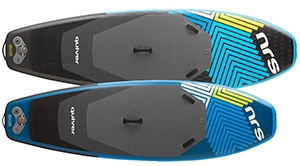Buying a whitewater SUP can be daunting when you have no idea what to look for. You want a rugged board that can withstand anything and one that is extremely maneuverable too.
If you’re confused by all the available options, I recommend my top seven best whitewater paddle boards in this comprehensive review. I also include a buying guide to help you pick the one that’s perfect for you.
My top choice is the Hala Atcha inflatable paddle board (Hala Atcha 7’11, Hala Atcha 8’6, Hala Atcha 9’6). There is a lot to say about it and I’ll go into details below. So read on.
The Best Whitewater Inflatable Paddle Boards
- Hala Atcha 7’11 x 34″, Hala Atcha 8’6 x 34″, Hala Atcha 9’6 x 36″
- Glide O2 Lochsa 10′ x 36″
- Hala Radito 10
- NRS Star Phase 10’2 x 32″, NRS Star Phase 10’6 x 34″, NRS Star Phase 10’8 x 35″
- NRS Quiver 9’8 x 36″, NRS Quiver 10’4 x 35″
- Hala Rado 10’10 x 35″
- Hala Carbon Hoss 11′
What Is the Best Paddle Board for Whitewater Stand Up Paddling?
Here are my top 7 recommendations for the best whitewater paddle boards of 2024.
1. Hala Atcha – Best Whitewater Paddle Board
The Hala Atcha is designed to be extremely maneuverable and durable, making it the ultimate action sports paddle board. You can get it in three sizes: 9’6 x 36”, 8’6 x 34”, and 7’11 x 34”. The shorter board would be great for river surfing as it is smaller with remarkable maneuverability.
Constructed using dual-layer dropstitch construction, the Hala Atcha is exactly what you need for a playful day at the river. It bounces off obstacles and won’t get punctured easily. It also comes with a three-year warranty, which is more than you get with most inflatable paddle boards.
One amazing feature of the Atcha is its retractable fin system. You don’t have to worry about breaking your fin when paddling shallow rivers, even those with rocky bottoms. The Atcha has a three-fin setup; two small side fins and a larger center fin.
The 7’11 Atcha has an additional removable nose fin, and there is also an extra rocker which keeps the nose from digging into the moving water. There are multiple carry handles on the deck as well as bungee storage at the front for your gear.
The large traction pad with a raised stomp pad at the back offers amazing control and maneuverability. The accessories on offer are impressive too! This inflatable whitewater SUP comes with a hand pump, rolling backpack, and a repair kit.
The Hala Atcha is ideal for all kinds of whitewater paddle boarding and paddlers of all skill levels, especially because you have different sizes to choose from.
- Retractable fin set: The Hala Atcha paddle board has retractable fins so they won’t get damaged when you’re river paddling in shallow waters.
- Grippy deck pad with stomp pad: The EVA deck pad on the Hala Atcha inflatable SUPs is large and grippy – but one notable extra is the stomp pad. I lov e this as it gives you remarkable maneuverability.
- Quality construction: The paddle board is built using dual-layer construction and comes with a three-year warranty. It is extremely durable and can handle rough conditions without getting easily punctured–which is exactly what you need for whitewater.
- Full rocker: Maneuverability is key when it comes to whitewater paddling and the Hala Atcha paddle board is incredibly responsive. You can easily make quick sharp turns whenever you need to.
- Three sizes available: Whitewater SUP is diverse and different conditions may require different size paddle boards – so it’s awesome that the Atcha comes in different sizing options. This means you can choose the Hala Atcha paddle board that best suits your paddling condition and skill level.
- No paddle in package: The Hala Atcha SUP board doesn’t come with a paddle in the package. This is fine if you’re buying this as an additional board and already own a paddle – but just be aware.
Check their prices here: Atcha 7’11, Atcha 8’6, Atcha 9’6
2. Glide O2 Lochsa – Best Budget Whitewater SUP Bundle
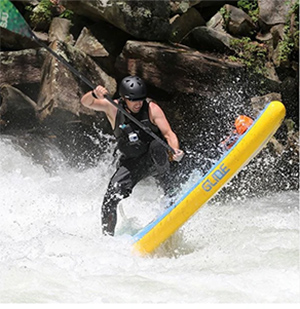
Whitewater paddle boards are expensive compared to other inflatable paddle boards. This can be disappointing for someone who wants to try river running but can’t afford to spend $1100 on a SUP. Luckily, you have a more affordable option–the Glide O2 Lochsa.
Although this is a budget whitewater SUP, the manufacturer didn’t compromise on quality. It features ultra-reinforced dropstitch and military-grade PVC construction. You can explore fast rivers all over the world, and the board will still hold up well. The rails are also reinforced for added durability and rigidity.
The paddle board has more rocker than your average all-around SUP, great for paddling in extreme conditions. The full-length deck pad offers a comfortable but grippy surface so you don’t slip and lose your footing on the wet board. There is bungee storage for your gear and a padded carry handle so you can easily carry your SUP around.
The Glide O2 Lochsa measures 10’ x 36” x 6” and can hold up to 400 pounds. It’s a nice whitewater paddle board for riders of all sizes. One thing that makes this the best budget option is that it comes with all the basic SUP accessories. You will get a paddle, leash, manual pump, rolling bag, and a repair kit.
You should consider the O2 Lochsa if money is tight but you still want a reliable SUP from a reputable company.
- Affordable: whitewater paddle boards can be a little too expensive for some people. The Glide is affordable and I love that it is still as high quality as many of the more expensive ones.
- Well-made: The Glide 02 Lochsa is built using reinforced drop stitch and durable PVC, resulting in a rugged inflatable SUP board that bounces off rocks and obstacles. To put it basically – it can take a beating!
- Super stable: The Glide river board is wide with an equally wide tail and you’ll be able to maintain balance even in choppy water – great for those who value stability while whitewater paddling, without sacrificing speed.
- Full-length deck pad: I love that the traction pad covers the entire deck so even when you move around you’ll have a grippy surface wherever you step.
- All-inclusive iSUP package: The Glide Lochsa comes with everything you need for your paddling trip. The package includes a paddle, pump, leash, and SUP bag.
- Not great for river surfing: The Glide 02 Lochsa is a little too wide and long for river surfing but perfect for river running.
Check Price of the Glide O2 Lochsa
3. Hala Radito 10’
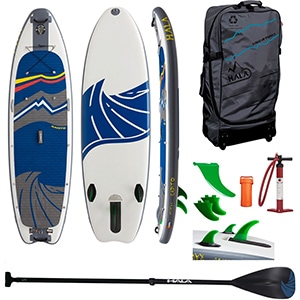
The Hala Radito is slightly longer than the Hala Atcha, measuring 10’ long and 34 inches wide. It is more of a whitewater and all-around hybrid SUP, especially for smaller paddlers.
The amount of rocker on the Hala Radito and its tail shape allow it to perform well, whether you’re on flatwater or running rapids. It has two small side fins and one bigger center fin which is retractable. The fins enhance maneuverability and tracking. The diamond groove deck pad offers traction and keeps you comfortable all day.
The Radito is built using double-layer dropstitch construction with PVC stringer to make it super rigid and long-lasting. You can be as adventurous as you like without having to worry about your SUP coming apart. It even has a three-year manufacturer’s warranty.
The Hala Radito has a raised stomp pad, like the Hala Atcha. It also has multiple grab handles which come in handy because this board weighs 31 pounds.
There are 12 rigging loops for your gear. When you’re not in the mood for river surfing you can attach a kayak seat and paddle leisurely at the lake.
If you are a smaller paddler looking for a flatwater SUP that will also perform exceptionally in whitewater, consider the Hala Radito.
- Ultra durable: The Hala Radito whitewater paddle board is built using dual-layer construction plus a PVC stringer. It is super rigid when inflated so you won’t have to worry about flex. The construction also makes it very durable and perfect for river paddling.
- All-inclusive package: Unlike the Hala Atcha, the Radito comes with a paddle, rolling backpack, and a pump. I love the backpack; it feels sturdy and the wheels make transporting the SUP so much easier.
- Traction pad with raised stomp pad: The deck pad is grippy and has a stomp pad at the tail and you’ll find it easy to control and maneuver the paddle board.
- Versatility: The Radito is mainly a river paddle board but it would also work as an all-around paddle board, especially for smaller paddlers. It is stable and it glides well too so you won’t be limited to whitewater paddling only.
- Heavy: This paddle board weighs 31 pounds which can be too heavy to carry around, especially over long distances.
Check Price of the Hala Radito
4. NRS Star Phase
NRS is a well-known brand in the paddle boarding world. They make some of the best specialized inflatable paddle boards in the industry and the NRS Star Phase is an outstanding whitewater SUP.
It is a stable all-around paddle board with a square tail. You can use it for a casual paddle boarding session on calm water or for mild river running. The SUP board comes in three sizes for you to choose from, 10’8 x 35”, 10’6 x 34”, and 10’2 x 32”.
The NRS Star Phase has four D-rings at the front that you can use to secure your gear. Its textured deck pad covers a large pad of the deck to give you a soft and grippy surface for your feet.
While this paddle board is built using amazing dropstitch construction and can handle rough conditions, it is super lightweight. The 10’8 SUP weighs 19 lbs, the 10’6 SUP weighs 17.5 lbs, and the 10’2 board weighs 16.2 lbs. It comes with a SUP bag, hand pump, and a repair kit.
The NRS Star Phase would be great for you if you want a quality all-around SUP that you can also use for running rapids.
- Three sizes available: The NRS Star Phase comes in three sizes, 10’8, 10’6, and 10’2. You can choose the size that suits you best depending on the whitewater conditions you want to paddle (as well as your lifestyle).
- Incredible stability: The Star Phase boards are wide and offer amazing stability even in rough waters. It also has a super grippy deck pad that ensures secure footing so you don’t easily fall off the board.
- Quality construction: This river board is made using rugged PVC and drop stitch construction. Unlike hard boards, it won’t get dented easily when you hit obstacles while navigating rivers.
- Lightweight: The three Star Phase boards are really lightweight, weighing only 19 lbs, 17 lbs, and 16 lbs. Whichever one you choose, you won’t have a problem carrying it–even smaller paddlers can portage it easily.
- No paddle: The NRS Star Phase doesn’t come with a paddle in the package but you get quality accessories including a pump and a backpack.
- Low weight capacity: The paddle boards have a lower recommended weight limit and may not be suitable for larger paddlers.
Check their prices here: Star Phase 10’2, Star Phase 10’6, Star Phase 10’8
5. NRS Quiver
The NRS Quiver is another amazing whitewater SUP from NRS and it comes in two sizes. There is the 10’4 x 35” and the 9’8 x 36”.
NRS SUP boards never disappoint when it comes to quality and the Quiver inflatable is no different. It is built using strong PVC and dropstitch construction. You can paddle through rapids with confidence, knowing that your paddle board is tough enough for almost anything. It comes with a three-year manufacturer’s warranty.
The Quiver has more rocker than a regular paddle board to enhance maneuverability and make it easy to ride waves. It features a two-fin system and both fins are removable and interchangeable. You can customize the setup to suit your paddling location.
You’ll love that the NRS Quiver comes with a backpack, repair kit, hand pump, and two sets of fins. The bag looks great and it is heavy-duty. Like most of the SUPs on this list, it doesn’t come with a paddle. It has carry handles for easy carry and D-rings for your gear.
If you want a stable and maneuverable paddle board for river running, check out the NRS Quiver.
- Tough and durable: The NRS Quiver features military-strength construction and comes with a three-year warranty. It’s perfect for a rough sport like whitewater paddling because you don’t have to constantly worry about punctures.
- Comes in two sizes: There are two NRS Quiver boards, one is 10’4 long and the other is 9’8 long. I love these length options because you get to choose the size that best suits you and your specific whitewater SUP lifestyle.
- Highly maneuverable: Both paddle boards are easy to maneuver and turn, even in tight spaces. They are responsive and playful–you are assured of a fun time in your river running adventures.
- Nice fin system: The NRS Quiver whitewater paddle board comes with a two-fin system. The fins are removable and interchangeable so you can play around with different fin styles to see what gives you the best performance.
- Low weight limit: The NRS Quiver doesn’t have a high capacity and may not be ideal for riders on the heavier side, so be aware.
Check their prices here: Quiver 9’8, Quiver 10’4
6. Hala Rado 10’10
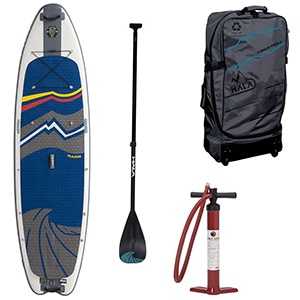
The Hala Rado is designed for versatility and it won’t limit you to just whitewater paddle boarding.
This SUP is 10’10 long and 35 inches wide, the size of a typical all-around SUP. It has a volume of 345 liters and can hold up to 325 pounds. With its large platform and higher weight capacity, the Rado is stable enough for paddlers of all sizes.
The Hala Rado features a three-fin system: two 4.5” removable side fins and an 8” retractable center fin. This, plus the extra curvature, results in a paddle board that will perform well in different bodies of water, including lakes and rivers.
Unlike the other Hala paddle boards here, the Rado comes with almost everything you need to start paddling right away. You get a quality rolling backpack, repair kit, manual pump, and an adjustable carbon paddle. (Carbon paddles are the lightest and most efficient for paddling). The only things you have to buy separately are a leash and a PFD.
The Hala Rado features rigging points and a bungee cord for your gear, multiple carry handles, and a grippy, soft EVA deck pad. It is also built using military-grade materials and comes with a five-year warranty.
I would recommend the Hala Rado for a taller or heavier whitewater paddler. It would also be great for any paddler looking for a versatile SUP that can handle different water conditions, including whitewater.
- Remarkable construction: With its thick fusion drop stitch construction and welded seams, the Hala Rado can take anything you throw at it. Plus, it comes with a five-year warranty–the best warranty period in the industry.
- Impeccable rigidity: I love how stiff the Hala Rado feels when it’s fully inflated, you could mistake it for a hard board. It is tailored for paddlers of all sizes and it can support up to 350 pounds.
- Retractable center fin: No need to panic when you find yourself paddling an area with shallow rocks. The center fin is retractable!
- Great iSUP package: The Rado comes with a backpack, carbon paddle, and a pump – which is a solid package. Carbon paddles are the most efficient for paddling and the most expensive too, so this is an amazing deal.
- A little heavy: The Hala Rado weighs 33 pounds which won’t be easy to carry but it’s a small price to pay for the heavy-duty construction.
7. Hala Carbon Hoss 11’
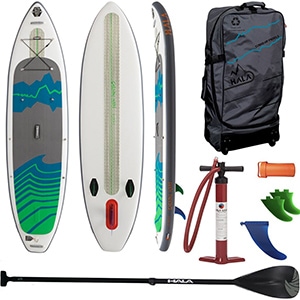
The Hala Carbon Hoss is the longest paddle board here, measuring 11’ x 33”. This is not the shape or size of a typical whitewater SUP board. It’s meant to be used for different SUP activities in different conditions.
Built using woven dropstitch and carbon stringer technology, the Hala Carbon is one of the most rigid iSUPs on the market. It doesn’t flex and will glide smoothly on the water. It is longer and narrower than the other models, a shape that enhances speed.
The Hala Carbon Hoss has a grippy, diamond-groove deck pad with a raised stomp pad to offer traction and improve maneuverability. It performs well on easy whitewater.
The stand up paddle board has a three-fin setup; two side fins and one large center fin, which help with performance. There are several rigging points and a shock cord for you to secure your stuff. The Hala Carbon iSUP bundle is amazing. It includes an adjustable carbon paddle, repair kit, hand pump, and a rolling backpack.
You should consider the Hala Carbon Hoss if you want a SUP that you can use for paddling various bodies of water, including slow-moving rivers.
- Versatile (you can use it for tons of different things!): One thing I love about the the Hala Carbon Hoss is the versatility. You won’t be limited to whitewater paddle boarding – you can paddle rivers one day, go on a SUP touring the next, and even try SUP fishing the day after that.
- Tri-fin system so you can change the setup: This river board comes with three fins, all of them removable. This makes all the difference because it allows you to change the setup and get amazing performance in different conditions.
- Quality construction: The Carbon Hoss is built using fusion construction and it has a carbon stringer, resulting in outstanding rigidity and durability. It doesn’t flex and you’ll enjoy a stable and fun ride.
- Great iSUP package: This inflatable SUP board comes with a carbon paddle, rolling backpack, and a high-quality hand pump. They are premium accessories and you don’t need to upgrade.
- No leash: Since this is more of a hybrid all-around and whitewater paddle board, it would have been nice to have a leash in the package.
Check Price of the Hala Carbon Hoss
Factors to Consider When Buying a Whitewater or River Surfing SUP
As you have seen from the paddle boards above, whitewater SUPs can come in many different shapes, sizes, and designs. To help you narrow down to one, here are the factors you should take into account.
1. Inflatable or Solid Paddle Board for Whitewater Paddling?
Both solid and inflatable paddle boards have pros and cons which make them better suited for different purposes. When it comes to whitewater, inflatable paddle boards are the best option. Here is why.
First, you can travel with it wherever you want. Not everyone is lucky enough to live near a river. Some paddlers have to travel for a real adventure, and even those who live close to a river may want to explore other whitewater spots. iSUPs fit in a bag when deflated making them ideal for transport and storage. You can even bring them on a plane!
The second reason is durability. If you go whitewater paddling, your paddle board will hit stuff, including rocks. It’s not a matter of if but when. The obstacles in the water are likely to cause serious damage to your solid SUP.
Inflatable whitewater SUP boards, on the other hand, are hard to puncture. They are made using military-grade PVC and are virtually indestructible. They are tough and can be used in any kind of condition. Besides, they are affordable compared to epoxy paddle boards.
2. Shape of the Paddle Board: River Running Vs River Surfing
If you will be river surfing, also known as park and play, you’ll need a very short SUP, 8 feet or shorter. River waves are much smaller than ocean waves and a shorter paddle board with more rocker is perfect for just that. The small size makes it maneuverable and the rocker prevents the nose from digging into the water.
River running or paddling rapids downstream requires stability and maneuverability. You want a paddle board that is slightly longer than a river surfing SUP by a foot or so and one that is wide. Wider boards are more stable. A board that is too long will be hard to control and if it is too narrow you will find it super unstable in rough conditions.
3. Is the Paddle Board Size Right for Whitewater Paddling?
This will depend on where you will be paddling. If you expect to be mainly river surfing, a short and narrow SUP is a great option, as mentioned above. It should be about 8 feet long and no more than 33 inches wide. For river running, you can get a 10-foot or shorter paddle board. You want unmatched stability so the width should be at least 35 inches.
You have seen that some boards above, like the Hala Rado and Hala Carbon, are longer. These are mainly crossover or hybrid stand up paddle boards. They are suitable for whitewater and all-around paddling. Highly specialized whitewater SUPs may not perform well in other conditions. So if you don’t want that limitation, a crossover SUP would be right for you.
Also, note that a crossover paddle board may not allow you to explore advanced rapids. River surfing will also be tricky with an 11-foot board.
4. Check the Fin Setup
The fin setup of a paddle board plays a huge part in its performance. A three-fin setup, with two side fins and one large center fin, is more common. The center fin helps with speed and tracking while the others enhance maneuverability.
You can also get a two-fin setup, with two side fins, like with the NRS Quiver. The setup comes in handy when paddling a river with shallow rocks.
To allow you to paddle in different terrain, get a setup that can be configured. This means having all-removable fins and a U.S fin box because it is versatile.
5. Is The Deck Pad Grippy and Large Enough?
Pretty much all paddle boards come with a deck pad. You just need to make sure that the SUP you get has a soft but grippy pad. The last thing you want is a slippery deck when running rapids. The deck pad secures your footing and gives you more control of the SUP.
Make sure the traction pad covers a large area because you never know how much you’ll move. Sometimes you don’t even have time to look where you ‘re stepping, so this is important.
Getting Started with Whitewater SUP: What You Need
Here are the basics for a safe and fun whitewater SUP experience.
1. A Whitewater Paddle
Choosing the right paddle is just as important as choosing the right SUP board for whitewater. With a good paddle, you will efficiently handle the SUP even in difficult situations.
a. Paddle Length
For whitewater paddle boarding, add 8 inches to your height to get the right paddle length. Some whitewater paddlers prefer shorter paddles so they will only add 6 inches. You bend slightly while running rivers and this makes a short paddle more comfortable to use. The best thing would be to get an adjustable paddle so you can experiment with different lengths.
b. Material
A whitewater paddle should be durable and lightweight, so you’ll want one made from carbon fiber.The problem is, carbon paddles can be a little on the expensive side, and not everyone wants to make that kind of investment. If that’s the case for you, go for a fiberglass paddle. Fiberglass is comfortably light and not as expensive.
Aluminum paddles are the cheapest but the heaviest. I wouldn’t recommend them for action sports such as river surfing.
c. Blade Size
Typically, bigger paddlers prefer bigger blades. Beginners may also find them comfortable because they offer a certain degree of stability. But know that you will have to use a lot of energy with every stroke.
Smaller blades are ideal for smaller paddlers. The strokes are more in a minute but they don’t require a lot of energy. This makes small blades good for people with injuries.
Try different paddles so you can choose the one that is perfect for you.
2. Personal Flotation Device (PFD)
Always wear a paddle board PFD when paddling. A PFD protects you from drowning; so never get on your paddle board without one. Life jackets have saved many people’s lives.
3. Leash
A leash keeps you attached to your board at all times. When you fall in the water, it is easy for the board to float away—which may leave you at risk. Some experts argue that a leash is not necessary, and can even be dangerous for whitewater. It could trap you and make it hard for you to swim to safety.
While this is a good argument, it is never advisable to go without a leash. The better option is to find one that has a quick-release mechanism. If you get trapped, you can release yourself quickly and get to the shore. The leash should also be attached to your waist and not your calf so that you can easily reach the quick release system in case of an emergency.
4. Protective Gear
Invest in the right kind of clothing for the conditions you will be paddling in, such as a wetsuit or a drysuit. Always prepare for immersion and it’s a good idea to buy a helmet as well. The board is not the only thing that can be damaged by rocks!
Note: Don’t forget to carry a whistle, knife, and a first aid kit! Safety first.
Whitewater Paddling Techniques
If it’s your first time tackling river rapids, there are some techniques you should master. The first and most important step is assessing the water.
Analyze the strength of the current and the direction. Does it lead to a dangerous place? Can you paddle against it?
Take some time to familiarize yourself with these whitewater paddling techniques, before you set out on a whitewater SUP session.
1. Entering and Exiting the Water
An eddy makes a great point of entry and exit. This is where the water hits an object, like a rock, causing it to slow down or flow upstream. For total beginners, this is a great spot to practice what you have been learning.
2. Stance
The most basic and common stance is the surf stance. Put one foot in front of the other, either in the regular or goofy position. With the latter, your right foot will be at the front. While standing like this, your weight should be evenly distributed on the paddle board.
The front foot helps with speed while the back foot is used in turning. As you become better at whitewater SUP, you can try other advanced stances.
3. Bracing
You will fall off the paddle board; but you don’t have to fall every time you hit a rough patch. Bracing is a whitewater SUP technique that can help you remain balanced. There is the low brace and the high brace.
a. The Low Brace
When making a forward stroke, there is the part of the blade that pushes the water back. It is known as the power face. The opposite side is the non-power face.
When the board starts to become unstable, bend your knees a little to lower your center of gravity. Place the paddle in the water, with the power face up. The blade should be several inches from the side of the paddleboard. With the blade in that position, slap the water. You will regain stability.
b. The High Brace
It is similar to the low brace, except in this case the power face is facing down. Make a forward stroke, but slap the blade as it comes into contact with the water.
4. Recovering After a Fall
Since falling is an expected part of running rapids, you need to know what to do when it happens.
a. Assess the Situation
Don’t start fighting with the water. Instead, stay calm and look around to know your options and see if there are any dangerous obstacles surrounding you. Check whether it’s better to detach yourself from the board and swim or get back up and continue paddling.
b. Whitewater Swimming
If you can’t get to the board immediately, float on your back. Keep your feet up and pointed towards the rapid. This is known as defensive swimming. After you get through it, turn back up and quickly pull your leash to get your board.
c. Getting Back on the Board
With your paddle in hand, hop back on to your SUP. If it has been flipped over, don’t try to turn it up from anywhere. Move to its center and flip it from there. Once you are stable, either continue paddling or go back to the shore and start over.
Safety Tips For Whitewater SUP
Safety is paramount with all SUP sessions, but even more so during the challenging conditions of whitewater paddling. Keep these tips in mind:
- Paddle away from trees: while in the water, trees are not your friends. Avoid them completely.
- Attend a program: there is a lot to learn about whitewater paddling. Some things, such as understanding whitewater situations, can only be learned practically. Find a pro or instructor.
- Don’t whitewater SUP alone: always go with a friend who is more experienced. Both of you can keep an eye on each other.
- Hold on to your paddle: when you fall, try not to release your paddle.
- Don’t stand: the rules of white water are a little different. When you fall off the board, never stand
Wrapping Up
Rivers provide an amazing way for you to challenge yourself as a paddler, but they can also be dangerous. You need to be fully prepared even before you get into the water.
The Hala Atcha is my top pick for the best whitewater paddle board. It is super maneuverable and rugged–exactly what a river paddler needs. Plus, it is available in three sizes for you to choose from. Hala Atcha 7’11 x 34″, Hala Atcha 8’6 x 34″, Hala Atcha 9’6 x 36″
If your budget is a little tight, I’d recommend the Glide 02 Lochsa. It is affordable but still well-made and it can take a beating. It performs well too, making for a thrilling ride.
Get the right SUP and paddle, learn all you can about river navigation, and buy the appropriate safety equipment. If you fall off the paddleboard, relax and follow the right steps. This means swimming defensively and not standing. Get back on your board and get to the shore or continue with the adventure.
Remember to have fun because that’s what it’s all about. Happy paddling!

